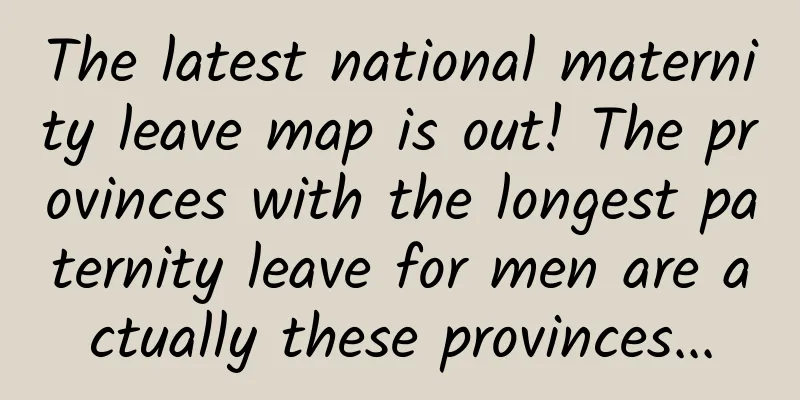The latest national maternity leave map is out! The provinces with the longest paternity leave for men are actually these provinces...

|
Recently, many places across the country have announced amendments to family planning regulations, increased maternity benefits, and extended maternity leave. So how many days of leave can you take after having a baby? According to the latest regulations in various places (as of November 27), the editor has compiled a list of the latest leave in many places across the country! What is maternity leave in general? Article 7 of the Special Provisions on Labor Protection for Female Employees issued by the State Council in 2012 stipulates that female employees are entitled to 98 days of maternity leave, including 15 days of pre-delivery leave; in the case of difficult labor, an additional 15 days of maternity leave will be granted; in the case of multiple births, an additional 15 days of maternity leave will be granted for each additional baby. Female employees who have a miscarriage before the fourth month of pregnancy are entitled to 15 days of maternity leave; those who have a miscarriage after the fourth month of pregnancy are entitled to 42 days of maternity leave. In addition, local governments have also stipulated local maternity leave on the basis of maternity leave stipulated by the state. The family planning regulations recently adjusted in many places across the country mainly adjusted maternity leave. Most provinces have extended maternity leave from the previous 30 days to 60 days. Therefore, when we talk about "maternity leave" in the usual sense, we actually refer to the sum of the number of days of maternity leave and childbirth leave. Maternity leave for women in many places has been increased to 158 days, and paternity leave for spouses is mostly 15 days On November 26, Beijing passed a decision to amend the Beijing Population and Family Planning Regulations, which will be implemented from the date of promulgation. The amended regulations stipulate that in addition to the maternity leave stipulated by the state, the extended maternity leave enjoyed by women will be increased from 30 days to 60 days. Together with the 98-day basic maternity leave stipulated by the state, the maternity leave for women will be increased to 158 days. Men will enjoy 15 days of paternity leave. Hubei, Anhui, Shanxi and many other places have similar latest regulations. Women in these places can take 188 days of maternity leave Article 31 of the "Jiangxi Provincial Population and Family Planning Regulations" revised by Jiangxi Province on September 29 stipulates that maternity leave will be increased by 90 days and men will be given 30 days of nursing leave, which means that women's maternity leave will be increased to 188 days. On November 24, Qinghai Province passed a decision to amend the "Qinghai Province Population and Family Planning Regulations", stipulating that women will be rewarded with 90 days of maternity leave and maternity leave will be increased to 188 days. On November 23, Hebei Province passed the revised "Hebei Province Population and Family Planning Regulations", which stipulates that couples who give birth to children in accordance with the provisions of laws and regulations, in addition to enjoying maternity leave stipulated by the state, will have their maternity leave extended by 60 days for the first and second children, and by 90 days for the third or subsequent children. In other words, couples who give birth to three children can take 188 days of maternity leave. On November 25, Zhejiang Province passed a decision to amend the "Zhejiang Province Population and Family Planning Regulations", stipulating that on the basis of enjoying the maternity leave stipulated by the state, the woman's maternity leave will be extended by 60 days for the birth of one child, for a total of 158 days; the maternity leave will be extended by 90 days for the birth of the second and third children, for a total of 188 days. In addition, women in Heilongjiang can take 180 days of maternity leave, and women in Chongqing can take 178 days of maternity leave. Many places stipulate that before the child reaches the age of three, both spouses can enjoy parental leave every year Many places have stipulated that before their children reach the age of three, each couple can enjoy 5 or 10 days of parental leave each year. Chongqing's parental leave can be up to one year On November 25, Chongqing passed a decision to amend the "Chongqing Population and Family Planning Regulations", stipulating that for employees who give birth in accordance with the provisions of laws and regulations, after the maternity leave or nursing leave expires, with the approval of the unit, one spouse can take childcare leave until the child is one year old, or both spouses can take a total of five to ten days of childcare leave each year before the child is six years old. The wages and benefits of female employees shall not be reduced due to breastfeeding. Recently, the National Health Commission and 15 other departments jointly issued the "Breastfeeding Promotion Action Plan (2021-2025)". The plan proposes that by 2025, the awareness rate of core breastfeeding knowledge in mother-child families will reach more than 70%, and the configuration rate of maternal and child facilities in public places will reach more than 80%. The plan requires that in order to protect the rights and interests of female employees during breastfeeding, employers must earnestly implement relevant provisions on labor protection for female employees, ensure that female employees enjoy maternity leave and birth reward leave, and reasonably arrange breastfeeding time for female employees during breastfeeding. For female employees who breastfeed infants under 1 year old, employers shall arrange 1 hour of breastfeeding time for them during daily working hours; if female employees give birth to multiple babies, 1 hour of breastfeeding time shall be added for each additional baby breastfed, and the breastfeeding time shall be deemed to provide normal labor. Employers shall not reduce the wages and benefits of female employees, dismiss them or terminate their labor (employment) contracts due to breastfeeding. Marriage leave is also extended "The marriage leave is too short and young people have no time to get married" recently became a hot search on Weibo, sparking heated discussions among netizens. The relevant local governments responded that they are adjusting the marriage leave system and will release the latest marriage leave policy in due course to better protect employees from holding weddings and honeymoon trips. Some provinces have increased marriage leave this year. For example, Jiangxi stipulates that those who get married according to the law will be given an additional 15 days of marriage leave in addition to the holidays stipulated by the state. Men also have an optimal reproductive age The incidence of infertility in my country continues to rise. In 1995, the infertility rate was only about 3%; from 2012 to 2018, the infertility rate rose to 10% to 15%, with the number of patients exceeding 30 million. It is expected that this rate will rise in the near future. In general, the incidence of infertility is about 10% to 15%, with male and female factors accounting for half each. From a genetic point of view, 25 to 35 years old is the best reproductive age for men. The sperm quantity and quality of men in this age group are at their best. Men with higher reproductive age will not only reduce the chance of pregnancy, but also lead to abnormal embryo development, increased health risks for offspring, and many other problems. (WeChat public account of "Healthy China") What is the optimal birth interval? With the adjustment of my country's population policy, a question that people are widely concerned about is: What is the optimal birth interval? The birth interval, also known as the interpregnancy interval (IPI), refers to the time interval between a birth outcome (including live birth, miscarriage, stillbirth, abortion, etc.) and the next pregnancy, usually referring to the time interval from a live birth to the next pregnancy. To reduce the risk of adverse pregnancy outcomes, the World Health Organization has recommended that women wait at least 2 years after their last live birth and at least 6 months after a miscarriage or induced abortion before becoming pregnant. The World Health Organization recommends 2 years, mainly to echo the UNICEF recommendation of 2 years of breastfeeding. Recent guidance issued by various medical institutions suggests that an interval of 18 to 24 months after the last live birth may be the best time to become pregnant again. This time is mainly recommended based on literature suggestions. When the IPI is 18 to 24 months, the risk to the mother and perinatal baby is the lowest. (Popular Health Magazine) Workers' Daily Client "Happy Health" Issue 152 Source: Workers Daily Client |
<<: "Zero Altitude House" allows you to conquer the Qinghai-Tibet Plateau
>>: Beijing residents are troubled by fleas. How can fleas still exist in the 21st century?
Recommend
Seed users, how to achieve growth from 0 to 1?
I believe that many startup teams have encountere...
A must-have file search tool for your computer, better than Everything
Overview In daily work and life, a common operati...
Introduction to comic line drawing for beginners
This course will teach you how to draw line drawin...
What is the specific function of Wenchang Tower?
1. If you can concentrate, your luck in studying ...
This food is suddenly popular! But be careful...
As summer vacation begins, many children are attr...
Qiancheng's toughest modification of mobile phone Douyin unmanned live broadcast
Qiancheng 6.29 latest unmanned live class + Douyi...
Qiqihar Railway University (How many points are there for Qiqihar Railway University)
There is no Railway University in Qiqihar. Even i...
The most advanced domestically produced "electric car" has a speed of only 0.2 kilometers per hour?
The winning works of the 2023 "China Science...
12 viewpoints on knowledge payment + fan fission operation!
In the context of knowledge payment , more and mo...
Chengdu Tea Selection Agent recommends a very reliable one to everyone [Sincere Night View]
Chengdu Tea Tasting Agent Selection: Senior agent...
Uncle Operations: I wish all CPs and channel partners in the mobile circle a happy Mid-Autumn Festival!
During this typhoon, I body exist Xiamen, a beaut...
It's obviously very clean, why is there still a strange smell in the refrigerator?
Review expert: Wang Guoyi, Postdoctoral Fellow in...
17 provinces hold provincial civil service examinations. When will the results of the provincial civil service examinations be announced?
17 provinces hold civil service provincial examin...
China Mobile's 4G construction will still be amazing next year: plans to build 300,000 base stations
Regarding the industry rumor that "China Mob...
8000-word long article | A comprehensive interpretation of Xiaohongshu's "professional account"
01. Say goodbye to corporate accounts and persona...









